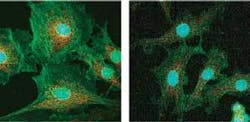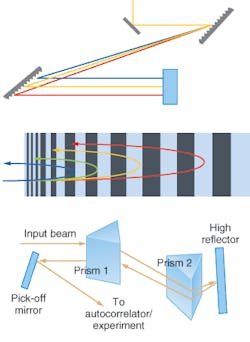TUNABLE SOURCES: Dispersion compensation sharpens multiphoton microscopy
VICTOR DAVID, ARND KRUEGER, AND PHILIPPE FERU
Femtosecond lasers are the most popular form of tunable laser in use today. Their inherent peak power allows for efficient nonlinear frequency conversion that results in the broadest spectral coverage of any type of laser. Furthermore, the high peak intensities of ultrafast pulses aid in the study of various samples, for example by stimulating nonlinear optical phenomena in the samples.
Since all-solid-state systems became available over a decade ago, the use of tunable femtosecond lasers has grown to the point where they have become a fundamental tool in many areas of science, including physics, chemistry, and biology. Materials scientists, for instance, probe the dynamics of electrons in carbon nanotubes by carefully tuning the laser pulse’s wavelength for time-resolved ultrafast spectroscopy. Biologists using multiphoton microscopy can use the same femtosecond IR light source to study dozens of different types of cancer, and physicists use tunable ultrafast laser sources to explore the specific responses of different nonlinear optical materials.
Ultrafast pulses present a set of unique challenges that often limit their ultimate effectiveness. For example, in multiphoton microscopy, in which fluorescence is generated through simultaneous absorption of two photons because of the high peak intensity of ultrafast pulses used, the effectiveness of the process is seldom optimized. Typically, a phenomenon called group-velocity dispersion (GVD), which broadens the ultrafast pulses as they pass through optical elements in the microscope, goes unchecked. This effect significantly reduces the imaging depth that can be achieved.
The use of very widely tunable (greater than 300 nm) ultrafast sources has increased in popularity, largely through the growth of multiphoton imaging, which requires wide tunability to reach the excitation maximum of a wide range of dyes. Because of the increasing use of such ultrafast sources, there is an acute need for a completely automated solution to compensate for pulse broadening at all wavelengths of very widely tunable ultrafast lasers.
Calculating GVD
Group-velocity dispersion can be described as a delay of shorter wavelengths with respect to longer wavelengths within the ultrafast pulse as it passes through an optical medium. This delay results in temporally broadened pulses delivered to the sample in most multiphoton imaging systems installed today. Until now, this broadening would go uncorrected because the techniques necessary to compensate for GVD have traditionally required a sophisticated optical layout that usually is incompatible with hands-free multiphoton-microscopy experiments.
Using Sellmeier coefficients, we can graph the actual amount of dispersion versus wavelength for a given amount of glass. A typical commercial multiphoton imaging system has many optical components: a fused-silica acousto-optic modulator, tube lens elements, and an objective. The dispersion of such a commercial imaging system equipped with a 63 × 1.4 NA (numerical aperture) oil-immersion objective was measured experimentally and found to be nearly equivalent to that for a 320 mm thickness of fused silica (see Fig. 1).
We can calculate the resulting pulse duration after GVD affects using the following formula:
where GVD (expressed in units of fs2) is group-velocity dispersion introduced by microscope optics and τ0 is the initial pulse width. For an initial pulse duration of 100 fs, the resulting pulse durations at the sample when using a 63× 1.4 NA oil objective are 702, 531, and 305 fs for wavelengths of 690, 800, and 1020 nm, respectively.
Compensation methods
Well-known techniques have been developed for compensating ultrafast-pulse broadening due to GVD. Until now, however, none has ever been automated successfully with the level of agility required for multiphoton-microscopy applications in terms of wavelength (a greater than 300 nm tuning range) and dispersion compensation (multiple microscope objectives). All of the techniques perform the same essential function of generating negative GVD by retarding longer wavelengths with respect to the shorter ones. The most popular techniques for dispersion compensation today are all based on the use of gratings, chirped mirrors, or prisms (see Fig. 2).
A grating pair can be used for pulse compression. Grating-based setups provide extremely high levels of negative GVD and are popular for applications that introduce very high levels of pulse broadening, such as pulse recompression of ultrafast amplifiers based on the CPA (chirped-pulse-amplification) technique. The main drawback of gratings is their relatively low efficiency with respect to other available forms of dispersion compensation; for this reason, they are only used when the level of compensation required is beyond the range of other techniques.
Chirped mirrors have special multilayer dielectric coatings that reflect shorter wavelengths at the layers closest to the front surface, while allowing longer wavelengths to penetrate deeper layers before being reflected. This introduces the delay of longer wavelengths needed to introduce negative dispersion.
Chirped mirrors have very low losses, making them an excellent choice for dispersion compensation when efficiency is extremely important. They are, for example, often used inside Ti:sapphire oscillators that produce pulses shorter than 30 fs. The amount of negative GVD provided by chirped mirrors is relatively low, however, especially when the mirrors are designed for broad wavelength coverage, and many “bounces” from the surface of chirped mirrors are necessary to introduce relevant levels of dispersion. For example, to compensate for the typical amount of dispersion at 800 nm, up to 100 bounces would be necessary. This could be achieved in a setup with multiple reflections on several chirped mirrors, but the necessity for changing the number of bounces to compensate for different amounts of GVD introduced by changing experimental parameters (for example, switching microscope objectives) leads to a complexity of alignment incompatible with microscopy applications.
A dispersion-compensation arrangement can be based on a prism pair. Although the additional glass of the prisms introduces additional positive dispersion, the spacing between them introduces negative dispersion, delaying longer-wavelength components. Altering the distance between the prisms allows for the adjustment of the maximum possible negative dispersion provided by the prism pair; thus, sufficient compensation is always possible if enough space is available to separate the prisms. Simply translating one of the prisms into the beam decreases the amount of compensation, allowing for easy adjustment across a very wide wavelength range if large enough prisms are used.
Although a prism pair is much easier to align than multiple bounces between pairs of mirrors, careful initial alignment is still necessary. The main drawback of using a prism pair is the distance required to separate the prisms. If laid out in a linear fashion, this can take up too much valuable table space to be practically implemented.
Automation over a wide range
Multiphoton microscopy is the most popular application of widely tunable lasers; therefore, there is a high demand for a solution that can compensate for up to 20,000 fs2 at 800 nm, typical of many commercial microscopes, and adjust for optimum compensation over a tuning range of 700 to beyond 1000 nm.
Responding to these demands, Newport’s Spectra-Physics Lasers Division has introduced a compact pulse compressor, the DeepSea, that attaches to the front of the company’s automated tunable femtosecond Ti:sapphire laser, extending its length by a mere foot.
A compact footprint is achieved by tightly folding the traditional linear layout of the dual-prism compensation method. The device automates the movements necessary to achieve optimal dispersion compensation across the laser’s tuning range, based on the number and composition of optical elements the beam will pass through-ensuring the shortest possible pulse where it matters: on the sample.
This compressor provides up to 35,000 fs2 of negative GVD at 690 nm, which is enough to compensate for any commercial multiphoton-imaging system, including all microscope and beam-delivery optics and an acousto-optical modulator that might be used for attenuation of the beam, with room to handle more material if necessary. Even though the positive dispersion to be compensated can vary significantly across the laser’s tuning range (690-1020 nm), the compressor will manage the required adjustments without compromising the stability of the output beam.
In the IR, where Ti:sapphire lasers operate, the change in refractive index with wavelength is almost linear; this fact allows a quick calibration of tuning across a range of wavelengths simply by optimizing GVD compensation at either end of the range. Compensation that is very near optimum for every wavelength is then calculated in between the endpoints. These automated calculations make it easy to recalibrate when the amount of glass in the optical path changes. For more precision in the calculation and optimization, a user can optimize more wavelengths in the range of interest, and save them together as a set in the machine’s memory. Once calibrated, the pulse compressor and laser operate in a fully automated manner across the wavelength range, ensuring the shortest pulse width at the sample.
Real-world results
With automated GVD compensation, shorter pulses can be delivered to the sample, providing higher peak power. In multiphoton imaging, this results in brighter images and deeper penetration into tissue at lower average power. In one example of the effect of dispersion compensation in imaging, two images are taken at the same photomultiplier-tube (PMT) gain settings and the same average power on a sample (see photos, p. 117). The left image, with a greatly improved signal-to-noise ratio, is taken with dispersion compensation provided by the automated laser/pulse-compressor combination.
Tunable ultrafast-laser sources have opened up a wide variety of applications in experimentation. They will, no doubt, continue to provide exciting new results. The ability to take full advantage of their output through such techniques as GVD compensation will provide utility for years to come.
VICTOR DAVID is product manager, ARND KRUEGER is director of strategic marketing, and PHILIPPE FERU is senior marketing manager at Spectra-Physics, A Division of Newport, 1335 Terra Bella Ave., Mountain View, CA 94043; e-mail: [email protected]; www.spectra-physics.com.




